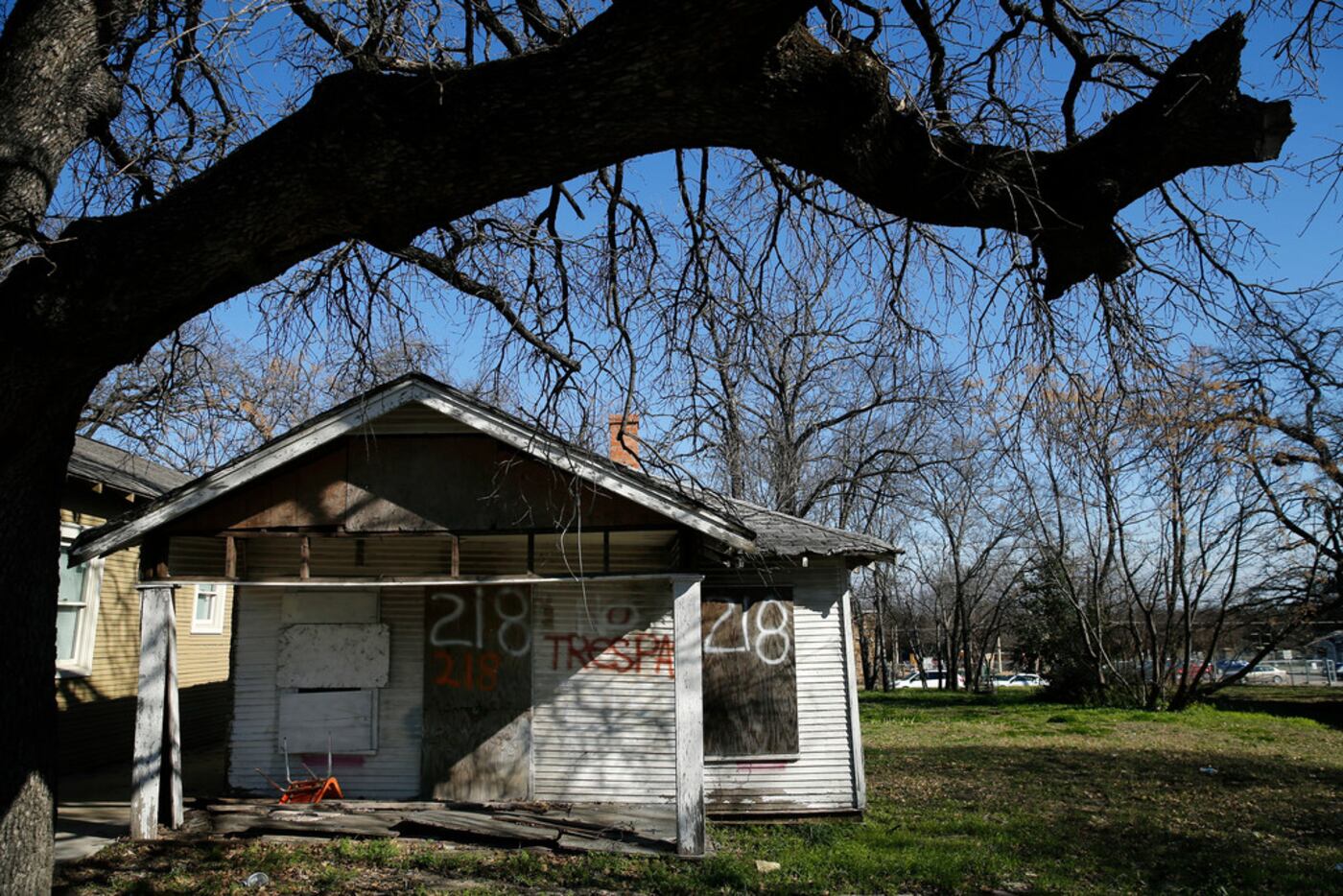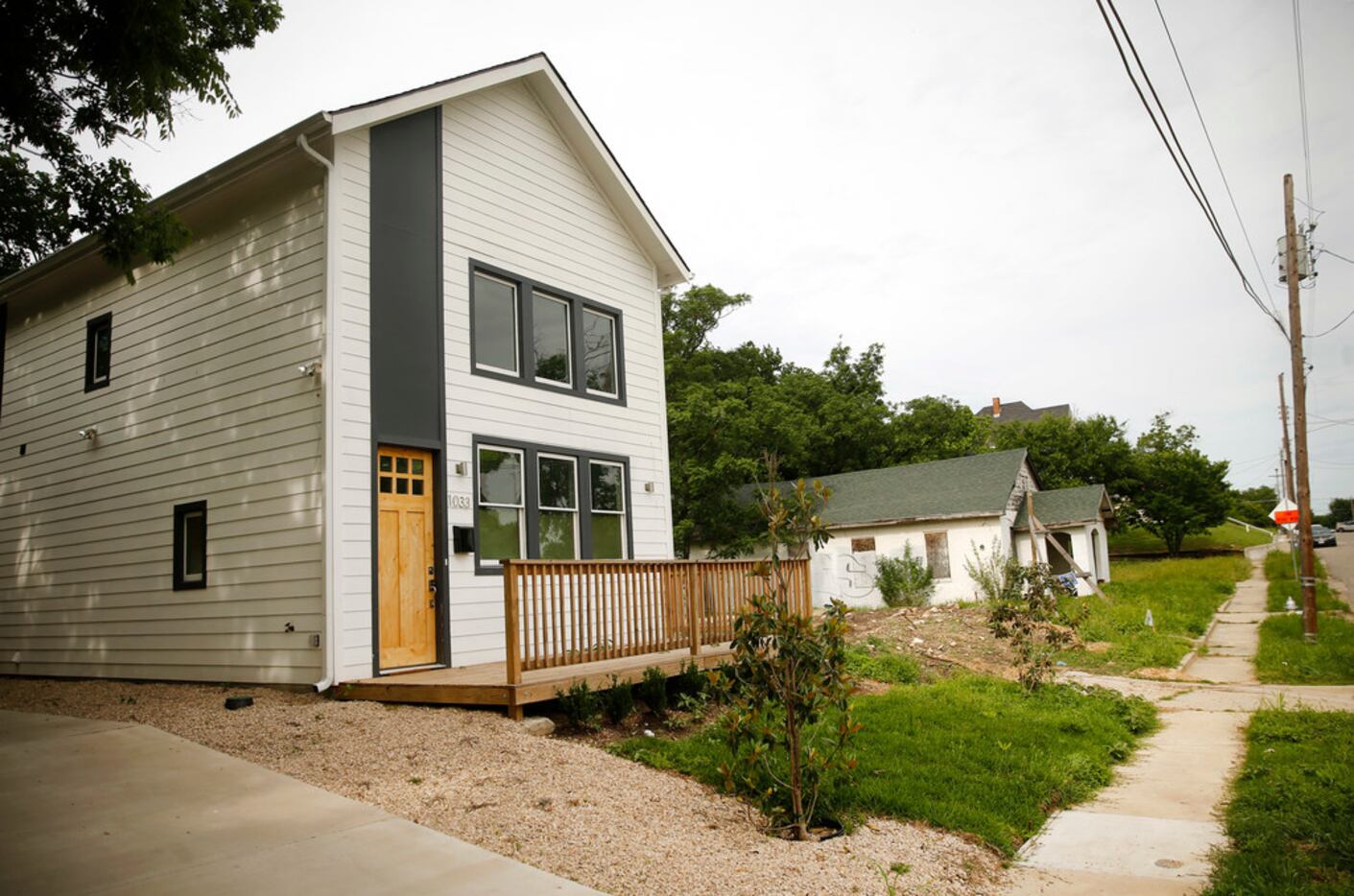Of all the houses that make up the Tenth Street Historic District, 218 N. Cliff St. is among the least remarkable. Nothing about it says special. Everything about it shouts teardown.
For many years, the rotting white Craftsman shotgun, nearly a century old, has been boarded up and overgrown, its facade spray-painted in giant letters "NO TRESPASSING." On occasion, cops respond to calls there, and at neighboring properties, to deal with drug deals and assaults and ditched cars stolen from the suburbs. Five years ago, the Dallas city attorney's office sued the old house's owner, at the time a Tyler-based nonprofit, to have the structure declared a nuisance in need of erasing. Without a single note of dissent, from the audience or horseshoe, on Jan. 5, 2015, the city's Landmark Commission approved 218 N. Cliff's demolition.
Yet, it survives — that eyesore, that danger — because the city ran out of money to demo the building, and because Carolyn King Arnold, the on-and-off council member for that neighborhood, demanded a timeout to demolitions in Tenth Street. On Monday, the house returned to Landmark for another go at demolition because Richardson developers are promising duplexes on several sites in Tenth Street, including at 218 N. Cliff St.
And this time the commission, unanimously, said no.
I have documented the reasons here before — because Tenth Street, originally a settlement for freed slaves dating to the late 1800s, is disappearing, a giant piece of this city's past erased. Many are to blame for its demise. Among the culprits: faraway and absentee owners who allowed demolition by neglect; speculators who bought land in the hopes of cashing in on the coming zoo deck park and left structures to rot; and City Hall, which allowed the gem of a neighborhood to tarnish without swift action.
For years, the city attorney's office found cooperative partners in Landmark Commissions that would sign off on demolitions with the shrug of the inevitable. Which is how, of the 257 homes in the area when it was designated historic by the City Council in 1992, more than 80 have been destroyed in recent years, and why there are so many concrete steps leading to weed-filled lots.
And the residents, terrified of developers who bring with them expensive new homes and expensive new property taxes, have said enough. They have formed a neighborhood association to counter the destruction of the past and displacement of the future. And that neighborhood association has sued the city in federal court, blaming "racial segregation and municipal services discrimination ... and unequal zoning" for the district's slow demise, according to recent court filings.

The lawsuit, which the city keeps trying to toss on technicalities, shrugs on. And the Landmark Commission, once quick to take an eraser to the city's history, is now loathe to participate in any further vanishings.
Laid bare again in council chambers during Monday's hearing was that battle for Tenth Street. Developers on the one side, insisting they will add by subtracting, and residents on the other, clinging to what little is left. And in the middle is the city, which seemingly has no plan or vision for the coming makeover that will wring what history is left from this historic district.
"We've been neglected for years," 75-year-old Patricia Cox told commissioners. Save for two decades away from Dallas, Cox has lived her entire life on Betterton Circle in a white 1938 house that looks like a movie set's re-creation of yesteryear. Cox told me later that when her parents bought the house in '43, it was already shabby, and they restored it to the condition in which it remains today.
"We need more time," Cox told the commissioners, her words as sharp as a tungsten needle. "It's sad that our houses are being taken away from us because of neglect by the owners, on purpose. We don't want the demolitions. We want to improve our neighborhood. We are improving our neighborhood. We've been overlooked by the city of Dallas and everybody else."
She added, a few seconds later, "We don't want to become another West Dallas," where whole neighborhoods have been devoured by developers.
Cox later told me of a sharp spike in her property tax bill in the past year — from about $700 to nearly $1,700, on a home now valued at $58,970. She fears the coming, inevitable gentrification will chase her from the family home.
"It's just too much," she said.
Speaking to the Landmark Commission, too, was DeLisa Rose, a RE/MAX realtor who told the commissioners she and her husband run Richardson-based Sterling Oasis Community and Economic Development Corporation. That's an IRS-approved 501(c)(3) affordable housing developer that bought several southern Dallas properties from the city's Land Bank before its recent overhaul, which came only after our reports about shenanigans.

Rose said nearby Greater El Bethel Baptist Church, on East 9th Street, deeded her nonprofit the land for redevelopment. She said Sterling Oasis is going to build duplexes on North Cliff elsewhere in Tenth Street because that's what is needed in the land of vacant lots.
Residents, she said, "want a great area, and sometimes people in the community don't understand what that means."
"It's not the home that's historic," she said, "but the area."
Rose said homebuyers do not want yesterday's troubles, a dilapidated shanty made whole again. They want "new plumbing, new pipes," she said, insisting that the demolition of 218 N. Cliff is a thing that must be done "not to destroy a neighborhood, but to build new homes that compete and compare to what a buyer wants."
Residents know they cannot stop the coming development, like the sleek new house HKS architect Jay Taylor built on a long-vacant 9th Street lot or the $235,000 two-story Alonzo Harris has planted next to a 1925 residence along Church Street. But they want an end to the demolitions. They want those new homes to look like the old ones, a requirement for historic districts that seems to have been ignored so far. And they want the new homes to take root on empty lots, not atop the bulldozed splinters of the remaining homes that allowed for the creation of the Tenth Street historic overlay of the 1990s.
"You don't understand what I am trying to tell you," Cox pleaded to Landmark commissioners finally sympathetic to the plight of the Tenth Street Historic District. "It's not just a neighborhood. It is not just a neighborhood. It's people's lives."

